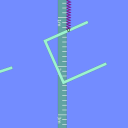Hooke's Law
From Algodoo
Hooke's Law
| Language: | English |
|---|---|
| Description: | Hooke's Law is a law used to measure the stiffness of a spring. A spring is said to be ideal if it follows Hooke’s Law. In this lab we will use Hooke’s Law to calculate the spring constant of 3 ideal spring. |
| Target: | Key Stage 4, Key Stage 5 |
| Category: | Laboratory |
| Discipline: | Static forces, Gravity |
| Learning objectives: |
|
| In class: | If students have not been introduced to Hooke’s Law previously, do so before engaging this activity.
Discuss if the force needed to stretch a spring increases, decreases, or stays the same as the stretch distance increases. Work at least one example using Hooke’s Law so students are familiar with the values and constants involved in the formula. Have students formulate their own procedures for how they could calculate the spring constant of actual springs. Their procedures should involve multiple measurements using different masses. Lastly discuss how students could graph their data and what the slope would represent. Once students have come up with predictions, encourage them to use the Create – Predict –Interact – Evaluate. |
Steps in Algodoo
CREATE A SCENE
Open ‘Hookes Law Lab’ scene above.
MAKE A PREDICTION
Have students record their predictions whether a high spring constant indicates a stiff spring or a flexible spring.
RUN/INTERACT
Using the given blocks in the scene, calculate the spring constant of each spring. The mass of the blue and purple blocks are given as well as the mass of the hangers. Take a minimum of 3 measurements for each spring.
FORMAT
For each data set, graph the data collected with stretch distance on the x-axis and force on the y-axis. For each graph, calculate the approximate slope of each data set.
EVALUATE
Is your data support your prediction? In each graph, what does the slope of each line represent? Based on the actual spring constant of each spring, calculate the percent error.
REVISE SCENE
Using the spring with the smallest percent error, calculate the mass of the green and red blocks. Again, calculate a percent error based on the actual mass of each block.




